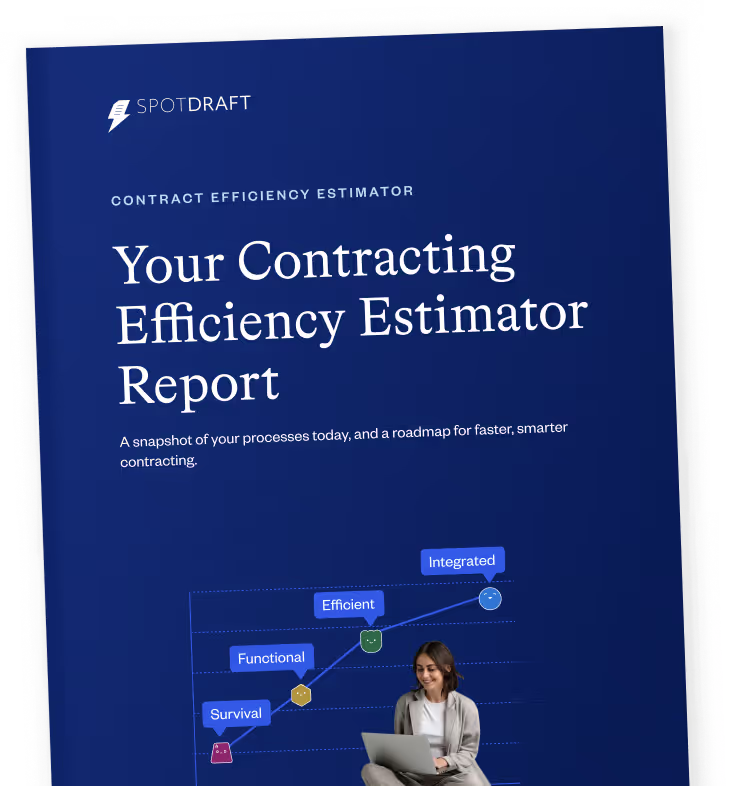TL;DR
- Contract review is one of the most time-consuming stages in the contract lifecycle.
- Traditional review is slow, costly, and hard to scale for growing legal teams.
- AI contract review automates repetitive tasks and improves speed, consistency, and compliance.
- AI works best for high-volume, low-risk contracts, while complex negotiations may still need human input.
- A blended approach allows legal teams to move faster without compromising on quality or control.
Legal teams today are facing increasing pressure to do more with less. As businesses grow, legal departments are expected to handle more contracts, complex regulations, and tighter timelines, all while maintaining accuracy and compliance. Contract review is often the most resource-intensive phase of the contract lifecycle, accounting for a significant portion of a legal team's workload. According to a recent report, legal teams spend up to 30% of their time on contract review, a figure that highlights both the time investment and the potential for inefficiency.
As the legal industry embraces technological advancements, AI contract review tools are emerging as a potential solution to streamline this process. These tools promise to reduce the time and effort required for contract review, but they are not always the perfect fit for every situation. This blog provides a side-by-side comparison of AI contract review and traditional review to help legal teams decide which option is best for their needs.
2. What Is Traditional Contract Review?

Traditional contract review is the manual process of reading, redlining, and analyzing contracts to ensure they align with organizational standards and legal requirements. In this process, legal professionals, such as in-house lawyers, external counsel, or paralegals, go through each contract line by line, comparing clauses against internal playbooks or external regulations.
However, traditional contract review comes with several challenges:
- Time-consuming: Reviewing each document manually takes significant time, especially at scale
- Inconsistent outcomes: Subjectivity leads to variability depending on the reviewer’s experience and workload
- Higher cost: Involving external counsel or senior legal professionals increases the cost
- Bottlenecks: Legal becomes a choke point in the contract lifecycle when the workload increases
In comparison, AI contract review addresses many of these problems by introducing automation and standardization.
3. What Is AI Contract Review?
AI contract review uses machine learning and natural language processing to analyze contracts faster and more efficiently than manual methods. These tools are designed to extract key data, detect deviations from standard language, and assist in redlining.
Core functions of AI contract review include:
- Clause extraction and flagging
- Deviation detection based on playbooks
- Suggested redlines for non-compliant or risky clauses
Key benefits of AI contract review:
- Speed and scalability: Handles large volumes of contracts rapidly
- Greater consistency: Reduces errors and subjective differences across reviewers
- Reduced legal workload: Automates repetitive tasks, freeing up time for strategic work
- Seamless integration with contract lifecycle management systems: Ensures smooth contract processing from start to finish
4. Head-to-Head Comparison: AI vs Traditional

Key takeaways:
Traditional review works best for contracts that require careful negotiation or contain unique terms. AI contract review is ideal for repetitive, high-volume reviews such as NDAs or vendor agreements. Legal teams that adopt a strategic blend of both approaches benefit from higher efficiency and reduced turnaround times.
5. How AI Contract Review Supports Contract Lifecycle Management
AI contract review strengthens contract lifecycle management by eliminating inefficiencies in the contract review phase. From intake to approval, AI helps legal teams move faster without compromising on quality.
AI improves contract lifecycle management through:
- Pre-signature review: Automatically surfaces risks or missing terms before execution
- Clause standardization: Aligns all contracts with internal templates and playbooks
- Automated approvals and escalations: Routes contracts to the right stakeholders based on predefined rules
Platforms like SpotDraft integrate AI contract review into the larger contract lifecycle management ecosystem, ensuring a smoother, more transparent workflow across departments.
6. When Should Legal Teams Use AI Contract Review?
AI contract review is best suited for:
- Reviewing high volumes of low-risk contracts, such as NDAs or partner agreements
- Reducing contract review cycle time across business teams
- First-pass review to prioritize which contracts need legal intervention
- Enforcing playbook standards consistently across geographies or business units
For lean legal teams, AI contract review provides a cost-effective way to scale contract operations without adding headcount or external counsel costs.
7. Why Sticking to Traditional Review Is Costing Legal Teams
Manual contract review is not only slow but also expensive and inconsistent. It depends heavily on individual reviewers and lacks repeatability, making it difficult to scale. When legal teams rely solely on traditional review, they often become a bottleneck that slows down deal cycles and increases business risk.
AI contract review solves for these issues by automating routine tasks, providing real-time insights, and ensuring adherence to internal standards. It reduces review timelines, improves output quality, and frees up legal resources for more strategic work. Forward-looking legal teams are moving away from legacy review methods and adopting AI as a scalable solution.
8. Final Verdict: Blended Contract Reviews are the Best
While AI contract review is not a complete replacement for legal professionals, it is an essential part of a modern contract workflow. By allowing AI to handle the repetitive, rules-based parts of contract review, legal teams can redirect their time and expertise to complex, high-impact work.
SpotDraft helps legal teams implement a balanced review model that combines automation with strategic oversight. Want to see how SpotDraft can streamline your contract review process? Reach out to schedule a demo.
FAQs
1. What is AI contract review?
AI contract review uses software to analyze contracts, flag risks, and suggest changes based on internal playbooks.
2. When should legal teams use AI contract review?
It is ideal for high-volume, low-risk contracts and first-pass reviews to speed up the legal workflow.
3. How does AI contract review support contract lifecycle management?
It streamlines contract review, improves clause consistency, and integrates seamlessly into CLM platforms for end-to-end efficiency.


.png)



.avif)



